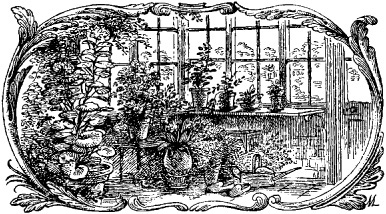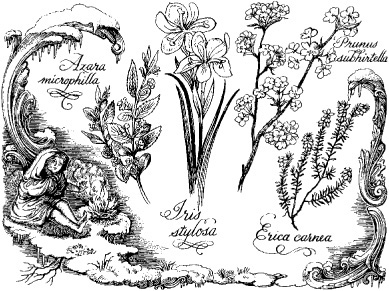
BROADENING THE FIELD

Throughout Nichols’s gardening writing, he maintains an abiding interest in four specialties: the Lilliputian world of rock gardens, the ecological renewal in planting trees, the extended growing possibilities through greenhouses, and especially the underappreciated joys of winter-blooming plants.
IT SEEMS ALMOST incredible that I could have been such a fatuous and ignorant optimist as to imagine that this was the way to make a rock garden—without any plan, without even an adequate preparation of the soil…. It reminded me of those puddings made of sponge-cake and custard, which are studded with almonds until they look like some dreadful beast thrown up from the depths of the sea. (DTGP, 111–112)
·
WHEN YOU ARE making a Rock Garden … you must be bloody, bold and resolute. By this I mean that you must stand at a little distance from your slope, visualize a certain broad design, and decide there and then to carry out that design, cost what it may. (DTGP, 114)
·
YOU MUST BE monstrously extravagant with your rocks. By which I mean that you must push them really deep into the earth…. It would be much more soothing to stick the rock on the top of the slope so that you could say ‘Look at my enormous rock! How rich I am to be able to afford such enormous rocks!’ But if you do stick the rock up like that, you will eventually take a hatred to it. Also, nothing will grow on it, and anyway it will certainly fall down. (DTGP, 115)
·
I HAVE ALWAYS been a fervent advocate of birth-control, but since I have been the owner of a rock garden my fervour has increased a hundred-fold. The prolificacy of the common saxifrage is positively embarrassing. The speed with which the rock rose reproduces itself brings a blush to the cheek. Violas appear to have absolutely no self-control, and as for the alyssum—well, if we behaved like the alyssum, Australia would be over-populated before the year is out. (DTGP, 116)
·
THE CHARM OF a rock garden is essentially Lilliputian. To extract the keenest pleasure from it you must be able to diminish yourself—you must acquire the talent for shrivelling yourself up into a creature that is able to walk, in spirit, under the tiny saxifrages, and shiver with alarm at their heavy weight of blossom, to climb, in your mind’s eye, the mossy stones, and grow dizzy on their steep escarpments. (DTGP, 123)
·
NOW THAT I was once again a regular subscriber to the garden magazines, the advertisements of the rock-garden merchants seemed like a personal affront. Campanulas three inches high—that was one of the things that made me gnash my teeth…. The advertiser said they would never be more than three inches high, and for some weeks, at least, one would have the pleasure of believing him. Belief is much more fruitful (and much saner) than doubt. Which is one of the secrets of a happy life. (GGTC, 219)
TO ME ALL woods are enchanted. I cannot imagine being lonely in them…. There are those who shiver and throw uneasy glances behind them when they plunge from the open country into the narrow, tortuous corridors of the trees—and many will skirt the borders of a wood rather than enter its dark recesses. But I feel that the trees are my friends, that I could wander naked among them without hurt, and sleep unharmed among their sturdy roots. (DTGP, 151–152)
THE WHOLE SENSE and spirit of a wood is at once aloof and protective—it retreats from you and yet it shelters too—brushing your cheeks with a sweet caress in spring, laying in autumn a pale, petalled carpet of fallen leaves at your feet, lacing the winter skies with an iron grille of frozen arms. (DTGP, 152)
·
A BEECH WOOD, which—like all beech woods—was pretending to be a cathedral. (SOTL, 154)
·
THERE IS SOMETHING lamb-like and poignantly innocent about the shrill green of a baby walnut tree. And all the very young conifers are fascinating, for you can almost see them grow. Half the fun of a wood is this memory of growth—this happy mental catalogue of branches that began as babies, are now reaching manhood, and oneday, will shelter you as you creep slowly beneath them towards the dying sun. (DTGP, 184)
·
IF YOU ARE in a position to plant a wood, and if you refrain from doing so, you must be, ipso facto, of a bleak and sullen disposition. You are to be shunned. It is arguable that your very existence should be made an offence in law. (MH, 176)
·
PLANTING A TREE is one of the most satisfying things a man can do. When you plant a tree you are perpetuating life, enriching the lovely land you live in, storing up a treasure house of beauty for your old age. (GOTD, 230)
TO GO TO the greenhouse when the weather is wild, to close the door, to stand and listen to the wind outside, to the rain that slashes the frail roof, to see, through the misted glass, the black, storm-tossed branches of distant elms, to take a deep breath, to savour to the full the strange and almost uncanny peace which this frail tenement creates—to me this is one of the truest joys which life has given. (DTGP, 210–211)
·
THERE IS NO more agreeable way of spending a lazy hour than by going down to the greenhouse and gravely swivelling all the pots whose plants are craning eagerly to the light. It makes one feel very grand and powerful. (GGTC, 151)

IT IS ALL so exhilarating that one wonders, not for the first time, why people do not live in greenhouses for ever. If everybody lived permanently in greenhouses, nobody—surely—would be foolish enough to start a war. (MH, 145)
·
A FLOWER OR a weed! I do not care whether they are weeds, in winter, in the greenhouse, in those little sheltered boxes. It is enough that they are green, that their leaves are like fans, that their stems are of infinite delicacy, with a mist of faint and poignantly adolescent hair, which is gilded by the lamplight. (DTGP, 223–224)
EVEN IN THE grimmest winter days a garden can give an appearance of discipline, and a certain amount of life and colour, no matter how wild the winds nor dark the skies. (DTGP, 25)
·
THIS PASSION FOR winter flowers has its roots deep, deep within me. I have a horror of endings, of farewells, of every sort of death. The inevitable curve of Nature, which rises so gallantly and falls so ignominiously, is to me a loathsome shape. I want the curve to rise perpetually…. I want my garden to go on. I cannot bear to think of it as a place that may be tenanted only in the easy months. I will not have it draped with Nature’s dust sheets. (DTGP, 52–53)
A buttercup field in mid-January! That is what the aconites will do for you, if you buy enough of them…. You cannot have too many aconites…. A thousand will make a brave splash of colour, which lasts a month. If you can afford ten thousand, you are mad not to buy them. (DTGP, 63)
·
THE FEATHERY, SPIDERY, yellow exuberance of this darling plant! For was there ever such bravery, such delicious effrontery, as is displayed, on many quiet walls throughout England, by the witch-hazel in mid-winter? Oh, it is much to be praised, infinitely to be exalted, this strong and delicate flower! There is something theatrical about it. To discover it, on a dark day, glistening epigrammatically in a forsaken world, magnificently pert and yellow, is so inspiring that one’s hands automatically begin to clap. (DTGP, 66)
·
IF YOU WANT a finer flower than [Iris unguicularis] in winter, you had better go and lock yourself up in your greenhouse and sing hymns. (DTGP, 70)
·
I HAD TO be content with protecting a few of the rarer winter flowers…. Every night, when I went to bed, I opened my window, and gently lifted in a spray of wistaria, which had clambered up to the glass and was beating its frozen fingers on the pane. (ATR, 168–169)
·
JANUARY WAS GAY and absurdly spring-like. Birds sang. There were sheets of golden aconites under the elm. The snowdrops laughed all day long. Somebody had told them that life was hard and difficult, whereas they found it bland and easy and delightful. (ATR, 175)

THE WINTER JASMINE was still spangled with flowers. They shone there, in the twilight, like late lamps burning in a secret wood. (AVIAV, 273)
THE DARKEST HOUR of the blackest week of the year could not hold me back, could not keep me indoors…. Somewhere, on some branch, there would be a bud to be welcomed. Somewhere, in the kindly shelter of a sturdy shrub, there would be the lifted tip of an emerald spear, thrust aloft through the dark earth by an impatient herald of spring. (AVIAV, 285)
·
OF ALL THE winter flowers I know none is braver nor more trustworthy than the winter aconite. You simply cannot keep it down. I believe that if you asked it, it would come up on an iceberg. In fact, in my garden, it almost did, because once I planted some aconites under a tree and very shortly afterwards the ground was flooded. Then a frost came along, and the ice remained under the tree for weeks. And in spite of this, the aconites came up and actually had the impudence to flower under the ice. (HDYGG, 36)
·
THE WINTER HELIOTROPE is a sort of colt’s foot, and very superior persons pretend to despise it. They say that it is dingy in colour—an observation which goes to prove that they are dingy in colour themselves. These critics also complain that it has a bad habit of spreading, and that once you get it in a garden, nothing on earth will ever get it out again. I cannot imagine any sane man wishing to get it out. (HDYGG, 39)
·
THE WINTER HEATHER, erica carnea … brings the warm glow of August into the depths of winter, and spreads its rosy carpet of blossom with sublime indifference to the frost and the snow. (MH, 153–154)
·
I REFUSED TO admit that there was ever a time of the year when the garden need cease to bloom, that there was not a single day, even in the snow, when it must be shrouded in dust sheets…. The best gardeners are three-hundred and-sixty-five-day-a-year gardeners, for long experience has taught them that some of the darkest days can also be among the brightest. (GOTD, 211–212)
